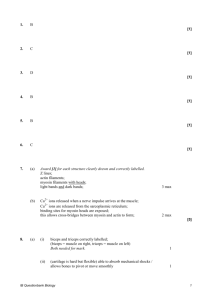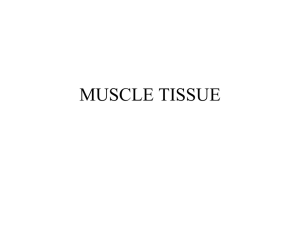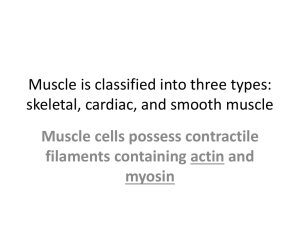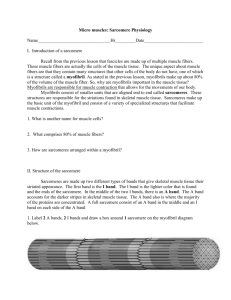STUDY GUIDE: Skeletal Muscle – microscopic anatomy
advertisement
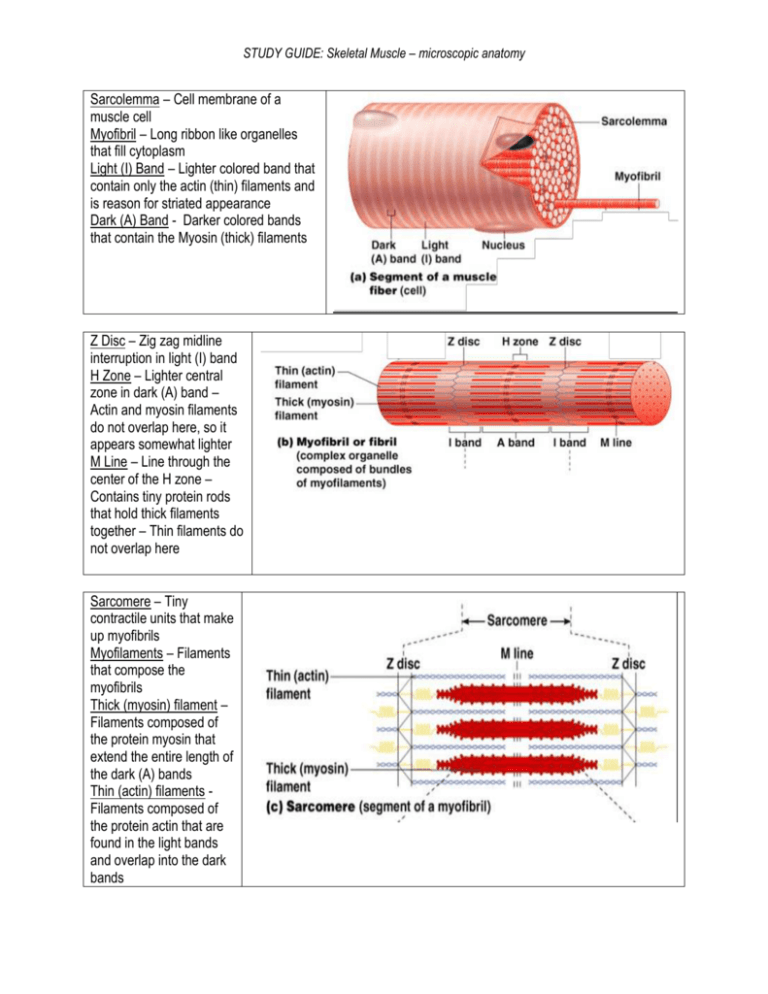
STUDY GUIDE: Skeletal Muscle – microscopic anatomy Sarcolemma – Cell membrane of a muscle cell Myofibril – Long ribbon like organelles that fill cytoplasm Light (I) Band – Lighter colored band that contain only the actin (thin) filaments and is reason for striated appearance Dark (A) Band - Darker colored bands that contain the Myosin (thick) filaments Z Disc – Zig zag midline interruption in light (I) band H Zone – Lighter central zone in dark (A) band – Actin and myosin filaments do not overlap here, so it appears somewhat lighter M Line – Line through the center of the H zone – Contains tiny protein rods that hold thick filaments together – Thin filaments do not overlap here Sarcomere – Tiny contractile units that make up myofibrils Myofilaments – Filaments that compose the myofibrils Thick (myosin) filament – Filaments composed of the protein myosin that extend the entire length of the dark (A) bands Thin (actin) filaments Filaments composed of the protein actin that are found in the light bands and overlap into the dark bands STUDY GUIDE: Skeletal Muscle – microscopic anatomy Cross Bridges – Studs on myosin filaments that link actin and myosin strands during muscle contraction Sarcoplasmic reticulum – Specialized endoplasmic reticulum found only in muscle cells that stores and releases Ca+ for use during muscle contraction Key Concept Questions 1) What are sarcomeres composed of and how are they arranged within a myofibril? Composed of Myofilaments Arrangement: Aligned end to end along the length of myofibrils 2) Write a brief paragraph that explains the arrangement of the following in a muscle fiber: Sarcolemma, Myofibrils, Nuclei, Dark (A) Bands, and Light(I) Bands. A muscle fiber is composed of myofibrils. A bunch of myofibrils and several nuclei are surrounded by the sarcolemma (Cell membrane). Each myofibril is composed of alternating bands: The Dark (A) bands and the Light (I) bands. STUDY GUIDE: Skeletal Muscle – microscopic anatomy 3) Label the following in the diagram below: Sarcolemma, Myofibrils, Nuclei, Dark (A) Bands, and Light(I) Bands. 4) Explain how the thick (myosin) filaments and the thin (actin) filaments are arranged within a myofibril. The thick (myosin) filaments are found in the dark bands. The thin (actin) filaments are attached to the z disc and run through the light bands and overlap the thick bands until halfway through the dark band. The H zone is where the thin filaments DO NOT overlap the thick filaments. The M line runs through the middle of the H zone and serves to hold the thick filaments in place. 5) Label the following parts in the diagram below: thin (actin) filament, thick (myosin) filament, Z disc (2 times), H zone, I band, A band, and M line. 6) While looking at the diagram above, explain what accounts for the striated appearance of skeletal muscle. The alternating I and A bands account for the striation. The presence of thick (myosin) filaments makes the A bands appear darker than the I bands, which have no thick filaments, just the thin filaments. 7) How does the M line contribute to the structure of a myofibril? The M line is the line that runs through the middle of the H zone and is composed of tiny protein rods that hold the thick (Myosin) filaments together which holds them in place. 8) What role do the myosin heads on the thick filaments play during muscle contraction? The myosin heads link the actin and myosin filaments together during contraction. This allows the contraction to be held by preventing the filaments from slipping back to their resting position. 9) Why is the sarcoplasmic reticulum essential for muscle contraction? The sarcoplasmic reticulum serves to store and release Ca+, which serve as the trigger for muscle contractions.


